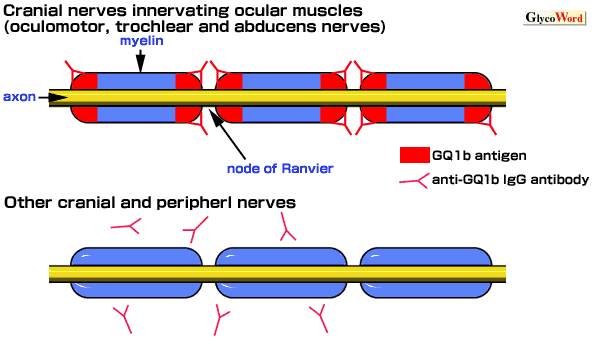Susumu Kusunoki
Department of Neurology, School of Medicine, University of Tokyo
Glycoconjugates including glycolipids and glycoproteins are cell surface molecules which are considered to be involved in cell-cell interaction and cell adhesion. It has been reported that antibodies against glycoconjugates are present in sera from patients with immune-mediated neuropathies such as Guillain-Barré syndrome, Miller Fisher syndrome, IgM paraproteinemic neuropathy, chronic inflammatory demyelinating polyradiculoneuropathy and multifocal motor neuropathy. Antibodies against glycoconjugates can be used as diagnostic markers for immune-mediated neuropathies. Although such antibodies are not necessarily involved in the pathogenetic mechanisms, some of them may be pathogenetic factors, considering that glycoconjugates are cell surface antigens.
Miller Fisher syndrome is a variant of Guillain-Barré syndrome, characterized by the triad of ophthalmoplegia, ataxia and areflexia. Infection precedes the onset of neuropathy in most cases. The syndrome follows an acute and self-limited course. IgG antibodies against ganglioside GQ1b are present in the acute phase sera from more than 90% of patients with this syndrome. Anti-GQ1b IgG antibody is also present in the acute phase sera from patients with Guillain-Barré syndrome with ophthalmoplegia. On the other hand, this antibody is never present in sera from patients with other neurological or immunological diseases,making it a very useful diagnostic marker. Immunohistochemical investigation has shown that GQ1b is specifically localized in the paranodal myelin of the cranial nerves innervating ocular muscles. The paranodal region is known to be important for nerve conduction. Anti-GQ1b IgG antibody therefore may cause ophthalmoplegia by specifically binding to those areas. Anti-GQ1b IgG antibody may be produced in response to the preceding infection.

Figure A hypothesis for the role of anti-GQ1b IgG antibody in the pathogenesis of ophthalmoplegia.
Anti-GQ1b IgG antibodies specifically bind to GQ1b antigen that is localized in the paranodal myelin of the cranial nerves innervating ocular muscles to cause ophthalmoplegia.
The other nerves, which lack in the dense localization of GQ1b antigen in the paranodal myelin, are not involved.
Antibodies that recognize the disialosyl residue of ganglioside GD1b are specifically associated with sensory ataxic neuropathy. Experimental sensory ataxic neuropathy is induced by sensitization of rabbits with GD1b, which is localized in the primary sensory neurons of dorsal root ganglia.
Antibodies against several other glycoconjugates, including myelin-associated glycoprotein, GM1, GD1a, GalNAc-GD1a and galactocerebroside, are known to be present in patients with some immune-mediated neuropathies. Some of the antibodies may bind to the glycoconjugate(s) with unique localization and determine the distribution of the damage in the pathogenesis of autoimmune neuropathies.